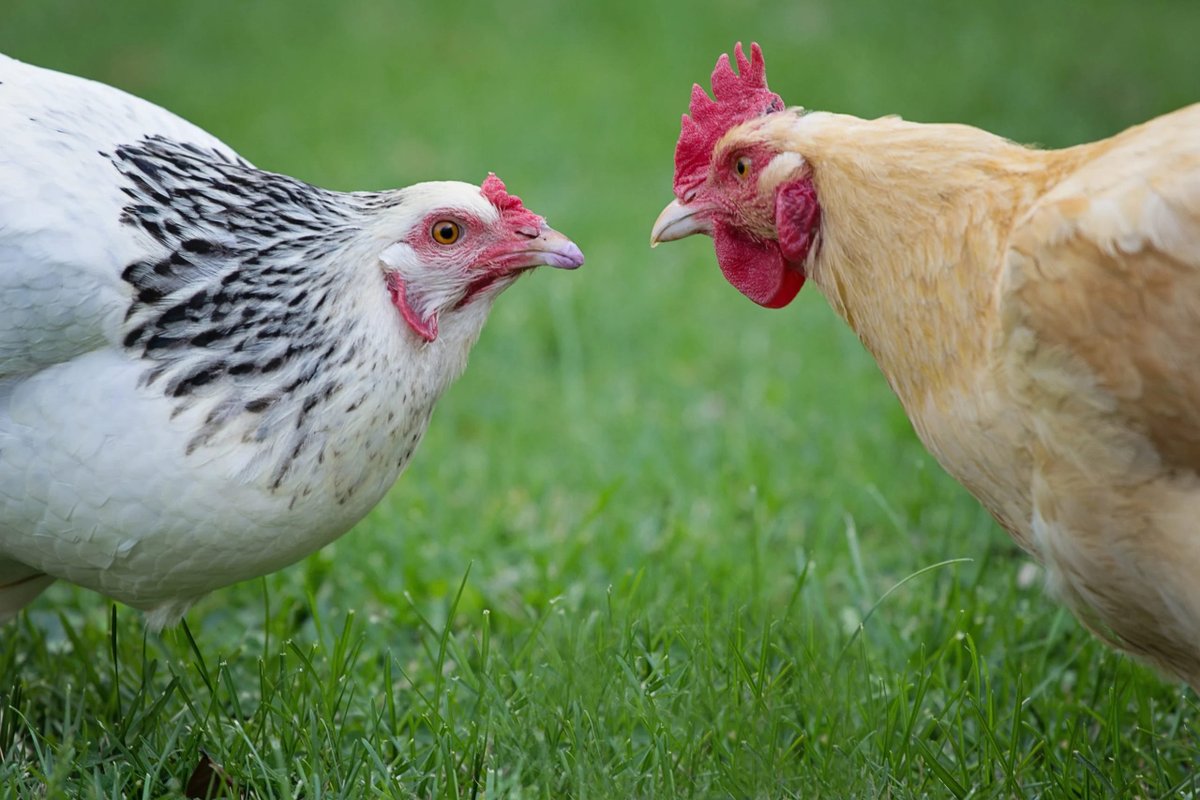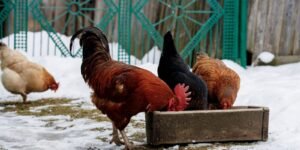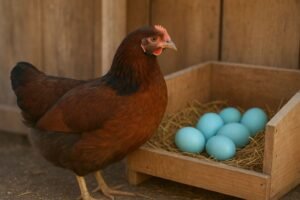If you’ve ever had a bully hen disrupt your peaceful coop, you know how stressful it can be. What starts as a simple squabble can quickly escalate into serious pecking order problems, causing injuries, stress, and a steep drop in egg production. You’re left wondering if this is normal flock behavior or something more sinister. This article is your guide to understanding flock dynamics and how to stop hen pecking to restore peace.
While every chicken flock has a social hierarchy that maintains harmony, there is a clear line between normal dominance and dangerous bullying. This article provides a comprehensive guide to understanding poultry behavior problems, identifying the signs of an aggressive hen, and implementing proven strategies to stop hen pecking and restore peace.
Understanding the Pecking Order
Every flock, no matter how large or small, operates with a clear social structure. This chicken pecking order hierarchy is a natural phenomenon, a method for maintaining order and ensuring that the most dominant birds have first access to resources. The term was coined by Norwegian zoologist Thorleif Schjelderup-Ebbe in a 1921 paper, which was the first scientific description of this chicken social structure in chickens. This natural flock hierarchy is an essential part of healthy chicken life.
What Is the Pecking Order?
At its core, the pecking order is a system that establishes dominance and predicts the outcome of conflicts. It reduces the number of fights by creating a clear structure where every chicken knows its place. Once established, it leads to a relatively stable and predictable environment. This hierarchy is typically established by 10 weeks of age in pullets (young hens) and somewhat earlier in cockerels. From an evolutionary perspective, this serves a practical purpose: it ensures the strongest individuals get priority access to resources for survival and reproduction.
“The pecking order is a resource guarding. Hens want to keep the best things for themselves and the pecking order determines first dibs. Despite the fact that chickens have no qualms about bossing underlings around, once the pecking order is set the flock should be peaceful with no obvious bullying, and certainly no terrorizing the low status birds into corners or drawing blood!” — Lisa Steele, Fresh Eggs Daily
The hierarchy is formed through dyad interactions—one-on-one confrontations where dominance is established. These interactions don’t always involve physical fights; often, a simple threat of aggression is enough to establish rank, and the submissive bird will back down.
Normal Pecking Order Roles
Within this hierarchy, each hen has a distinct role, from the top of the ladder to the bottom.
- Alpha Hen (The Boss): This is the top hen of the flock. She is the first to eat, the first to drink, and she claims the best roosting spot. She maintains order and protects the flock, including herding the flock to safety when predators appear.
- Beta Hens (The Lieutenants): These hens are right below the alpha hen. They have a relatively stable position and will often reinforce the alpha’s decisions, but they will also challenge lower-ranking birds.
- Middle Management: This is the large, peaceful middle ground of the flock. These hens usually avoid conflict and stick to their preferred areas. They generally get along with each other and are not overly concerned with dominance.
- Bottom Hen (The Omega): These are the lowest-ranking chickens in the social structure. They are the last to eat and often avoid conflict by staying away from the more dominant birds and other submissive birds.
A normal pecking order is dynamic and fluid. Occasional pecks, chest bumps, or brief chasing are all normal dominance displays. These are usually quick corrections, not prolonged attacks, and they rarely cause injuries.
The Rooster’s Role
While this guide focuses on hens, it’s important to understand how a rooster fits into the dynamic. In a mixed-gender flock, a rooster typically sits at the very top of the hierarchy. His primary role is to act as a protector and peacekeeper. A well-mannered rooster will often intervene to break up squabbles between hens and protect the flock from predators. His presence can significantly reduce aggression and help stabilize the pecking order, as hens are less likely to fight over the alpha position when the top spot is already taken. However, if there are multiple roosters or a poor rooster-to-hen ratio (fewer than 8-10 hens per rooster), they can become aggressive and fight amongst themselves.
Identifying a Bully Hen vs. Normal Behavior
While a little bit of pecking is natural, you need to know how to spot the difference between a normal dominance display and a serious backyard chicken bullying problem. A true bully hen goes beyond simply maintaining order; she creates chaos and often causes physical harm. Learning to identify alpha chicken behavior is a key first step to understanding what a healthy flock hierarchy should look like.
Signs You Have a Bully Hen Problem
A bully hen consistently and relentlessly targets another bird. She is a source of constant coop stress. Here are the key signs of a bully hen:
Physical Signs:
- Persistent aggressive pecking: The aggressor repeatedly pecks at a specific hen, causing injuries.
- Blood is drawn regularly: This is the most crucial sign that you need to intervene.
- Feather loss on specific birds: A bullied hen may have bald spots on her back, head, and neck. These are often signs of relentless pecking or being mounted aggressively.
- One hen constantly cornered or isolated: The victim is frequently found hiding in a corner, unable to access food, water, or roosting spots because the bully hen is standing guard.
Behavioral Signs:
- Preventing others from eating or drinking: The offender will monopolize resources, even if there are multiple feeders and waterers.
- Relentless chasing without provocation: An aggressive bird will chase a specific hen around the run or coop for no apparent reason.
- Attacking sleeping or roosting birds: A normal dominant chicken will not typically attack a hen on the roost at night. A bully hen, however, may continue her harassment even when the flock is at rest.
How to Tell Which Hen is the Boss vs. a Bully
It’s important to differentiate between a healthy alpha chicken and a bully hen. A healthy alpha hen uses her dominance to maintain order and protect her flock, while a bully hen is a tyrant who creates chaos. You’ll notice a marked difference in the intensity of their dominant hen behavior and other hen dominance issues.
| Normal Alpha Hen | Bully Hen |
|---|---|
| Maintains order | Creates chaos |
| Eats first but shares | Monopolizes resources |
| Protects the flock | Terrorizes the flock |
| Gives quick corrections | Engages in prolonged attacks |
| Doesn’t draw blood | Causes physical injuries |
When you see a hen that is constantly causing trouble and preventing other birds from thriving, it’s a clear sign you have an aggressive hen who needs to be dealt with.
Preventive Observation: Catching Problems Early
You can often spot pecking order issues before they escalate by observing your flock during specific, high-stress times. Pay close attention to their behavior:
- When you are giving treats: Watch for a single hen monopolizing the treats and preventing others from getting any.
- During mealtime: Observe how the chickens interact around the feeder and waterer. A bully will often stand guard and deny others access.
- When it starts raining: Sudden changes in weather or environment can cause stress and trigger aggressive behavior.
- After you have moved something in the coop: A change in the layout can cause temporary confusion and minor conflicts while the pecking order is re-established.
By being proactive and observing these behaviors, you can often intervene before a small problem becomes a serious one.
Why Hens Become Aggressive: Uncovering the Root Causes
Before you can fix the problem, you must understand why it’s happening. Aggression is usually a symptom of a deeper issue that leads to pecking order problems. Many of these triggers are mistakes every first-time chicken keeper makes, but they are easily corrected. If you find yourself asking “Why are my chickens attacking one hen?” it’s likely due to one of these common factors.
Environmental Triggers
The most common causes of aggression are directly related to the coop and run environment. A stressed flock is more likely to fight. This same stress can also lead to other unwanted behaviors, such as chickens eating their own eggs. A key component of flock management, therefore, is creating a comfortable space. Poor coop design can impact animal welfare.
- Overcrowding: Chickens need space. Less space leads to stress, which can trigger aggressive dominant hen behavior. Poultry experts recommend a minimum of 4 square feet indoors and 10 square feet outdoors per bird.
- Inadequate Resources: Not having enough feeders, waterers, or nesting boxes can lead to fierce competition.
- Boredom: If chickens are confined to a small, unstimulating space, they can become bored and take out their frustration on each other.
- Changes in feed: A sudden change in diet can cause stress and upset a hen’s digestive system, leading to aggression.
- Rodent disturbances: Rodents in the coop can cause stress and disrupt the flock’s routine, leading to increased aggression.
“When chickens of any age bully other chickens, the behavior must be interrupted, the cause determined, and the bully, reformed.” — The Chicken Chick
She clarifies that while “the occasional peck or nudge is to be expected,” repeated, aggressive behavior causing injury is “not normal, nor acceptable.”
Health-Related Causes
Sometimes, aggression can be caused by a health problem. An aggressive bird may feel unwell, which makes her irritable.
- Nutritional Deficiencies: A diet lacking in protein or essential vitamins and minerals can make chickens irritable and aggressive.
- Parasites: External parasites like mites and lice can cause a hen to become stressed and agitated, leading to aggression.
- Hormonal Imbalances: Hormonal changes can cause a hen to act out of character, including showing aggression.
Social Disruptions
Chickens are creatures of habit. When their chicken social structure is disrupted, they can become stressed and aggressive, leading to pecking order problems.
- Introducing new chickens. This is the most common cause of pecking order disruption. The flock must re-establish its entire chicken pecking order hierarchy, which can lead to conflict.
“A group of chickens should quickly reach an agreement, and each hen will know her status.” — Terry Golson, HenCam
She adds that if a well-established flock has “frequent squabbles, or if a hen is getting bloodied, then you have a management issue.”
- Removal and reintroduction: Removing a hen for a short time (e.g., to treat an injury) can cause her to be seen as an outsider when she returns.
- Loss of a flock member: The death or removal of a top hen can create a power vacuum, causing the remaining hens to fight for the top spot.
Genetics and Breed Tendencies
A hen’s disposition is also influenced by her breed. Some are naturally more dominant, while others are known for their docile nature. Breeds like Orpingtons, Cochins, and Wyandottes are often more laid-back and great for mixed flocks, whereas assertive breeds like Rhode Island Reds, Leghorns, and Barred Rocks may be more prone to dominant hen behavior and initiating pecking order issues.
Interestingly, a chicken’s comb style can also play a role in their rank. Studies have shown that chickens with a single comb often rank higher in the pecking order than those with other comb styles, such as rose or pea combs.
“Aggression becomes a problem when it leads to injury or becomes pervasive within a flock… when injury occurs, generally in the form of head and comb wounds, the afflicted bird should be removed and the wounds cleaned.” — The Merck Veterinary Manual
How to Stop a Bully Hen: Immediate Intervention Strategies
Once you have identified your bully hen, you need to act quickly. The longer you wait, the harder it will be to stop hen pecking. These are the most effective aggressive hen solutions.
When to Intervene
You should intervene immediately if you see these signs:
- Any time blood is drawn.
- Continuous harassment of a hen that lasts for more than a few minutes.
- A hen is being prevented from eating or drinking.
- A hen is cornered and terrorized.
How to Stop a Bully Hen – Step by Step
Step 1: Separate the Offender
This is the most critical step to stop hen pecking. You need to remove the bully hen from the flock immediately. Place her in an isolation pen where she can still see her flock mates but cannot physically interact with them. This isolation resets her position in the flock’s hierarchy. The answer to “how long to isolate a bully hen” is typically 3-7 days, but for severe cases, you may need up to two weeks.
Step 2: Treat Injured Birds
While the bully hen is in isolation, check the other hens for injuries. Clean any wounds with a saline solution and apply an antibiotic ointment. Chicken saddles or aprons can protect a hen’s back if she is being pecked frequently.
Step 3: Address Root Causes
While the bully hen is away, take the time to address the underlying reasons for the aggression.
- Increase space in the coop and run if it’s too crowded.
- Add multiple feeding and watering stations to prevent resource guarding.
- Provide enrichment activities to combat boredom.
Step 4: Reintroduction Process
After 3-7 days, it’s time to reintroduce the offender. The best time to do this is at night, when the flock is roosting and calmer. The goal is to reintroduce her in a low-stress environment. It’s important to know that if a hen is removed for a couple of weeks or more, she will be treated like a new hen because her old position in the hierarchy will have disappeared.
How to Reset Chicken Pecking Order: Long-Term Solutions and Prevention
Fixing a pecking order problem is not just about isolating the bully; it’s about creating an environment where aggression is less likely to occur. Here are some solutions for effective flock harmony management and chicken conflict resolution.
Environmental Management
- Space Solutions: Make sure your coop and run have enough space. Add multiple levels and hiding spots for lower-ranking birds to escape. Deciding between a dedicated chicken run vs. free-range options can also impact your flock’s stress levels.
- Resource Management: Ensure you have enough feeders and waterers. A good rule of thumb is one feeder per 4-6 birds. Adding extra nest boxes (one per 4 hens) can also reduce stress.
- Chicken Enrichment: Combat boredom with engaging activities that provide mental stimulation and satisfy their natural instincts. Hanging a head of cabbage, squash, or lettuce in the run encourages foraging behavior and gives the chickens something to peck at. This can help with flock stress reduction. These are excellent boredom busters for your hens.
Gradual Introduction Method
A common and highly effective method for introducing new birds is to use a wire barrier. This allows for a slow, low-stress integration. To do this, you can:
- Split the coop or run in half using a chicken wire or a similar sturdy mesh.
- Place the new birds on one side and the existing flock on the other.
- Let the two groups get used to seeing and hearing each other for about two weeks. This period allows the chickens to establish a new social order without physical confrontation.
- After the acclimation period, remove the barrier at night after the chickens have gone to roost. When they wake up in the morning, they will see the new birds as a natural part of the flock, which helps prevent a massive fight.
Home Remedies and Behavioral Interventions
If you’re looking for home remedies to stop pecking order problems or other simple solutions, consider these options:
DIY Anti-Peck Spray
You can create a simple, homemade spray to deter pecking. The goal is to make the targeted hen taste unpleasant to the bully. A common method is to mix a small amount of apple cider vinegar with water and add a few drops of bitter-tasting (but chicken-safe) essential oils like mint or licorice. Always research every ingredient to ensure they are not toxic to chickens, and test the spray on a small area first to make sure there is no adverse reaction.
- Pinless Peepers: These are small devices that clip onto a chicken’s beak to block their forward vision. They prevent the hen from accurately aiming her pecks.
- Anti-peck spray: There are many commercial solutions on the market that taste bad to chickens and deter pecking. When considering if “does anti-peck spray work for chickens”, the answer is yes, it can be a very effective deterrent for mild pecking issues by making the target hen less appealing to the bully.
Frequently Asked Questions About Pecking Order Problems
Q: How long to isolate a bully hen?
A: A bully hen should typically be isolated for 3 to 7 days. This period is long enough to reset her social standing without causing excessive stress to the bully or the rest of the flock.
Q: Does anti-peck spray really work?
A: Yes, for many cases of mild to moderate pecking, commercial anti-peck sprays can be very effective. They work by leaving a foul taste on the feathers, making the bullied hen an unappealing target for the bully.
Q: Why are my chickens attacking one hen?
A: This usually happens when the targeted hen is sick, injured, or looks different from the other birds. Chickens have a strong instinct to drive out what they perceive as weak members to protect the flock from predators.
Q: How do you identify a bully hen?
A: A bully hen is a dominant chicken that consistently targets other birds, often causing physical injuries and preventing them from accessing food and water. Unlike a normal alpha hen, a bully creates chaos and terrorizes the flock.
Q: What are some home remedies to stop pecking order problems?
A: Providing adequate enrichment is a great home remedy. You can hang a head of cabbage or other leafy greens in the run to give your hens something to peck at, which can help redirect their aggression and reduce overall flock stress reduction.
Q: What is a pecking order disruption?
A: A pecking order disruption is an event that breaks the established flock hierarchy, causing chickens to re-establish their roles. This often happens when you introduce new chickens to the flock or when a key member (like an alpha hen) is removed.
Q: How do you reset a chicken’s pecking order?
A: To reset chicken pecking order, you need to remove the bully hen from the flock for a few days to disrupt her dominance. When reintroducing her, do so at night and make sure you’ve addressed any underlying issues like overcrowding or boredom.
Q: How can I reduce flock stress?
A: The most effective ways to reduce stress and prevent poultry behavior problems are to ensure your coop and run are not overcrowded, provide multiple feeders and waterers to prevent resource guarding, and offer plenty of boredom busters to keep the hens occupied.
Q: How do I reintroduce a bully hen after isolation?
A: The best way to reintroduce a bully hen is at night, after the flock has gone to roost. This allows her to rejoin the flock in a low-stress environment and gives her a chance to be accepted back in without immediate conflict.
Conclusion
Successfully managing a bully hen problem is a testament to proactive and attentive flock care. By understanding the root causes of aggression and learning to distinguish normal pecking order behavior from bullying, you can intervene effectively and restore peace to your coop. Remember that a happy flock is a healthy flock, and the small effort you put into observation and management will pay off in the long run.
Have you ever dealt with a bully hen? Share your experience and what worked for you in the comments below!

Oladepo Babatunde is the founder of ChickenStarter.com. He is a backyard chicken keeper and educator who specializes in helping beginners raise healthy flocks, particularly in warm climates. His expertise comes from years of hands-on experience building coops, treating common chicken ailments, and solving flock management issues. His own happy hens are a testament to his methods, laying 25-30 eggs weekly.



